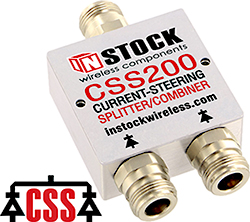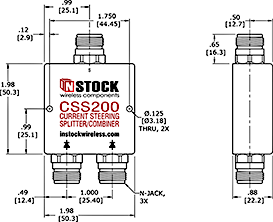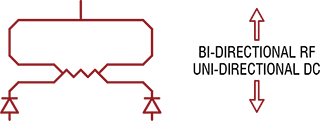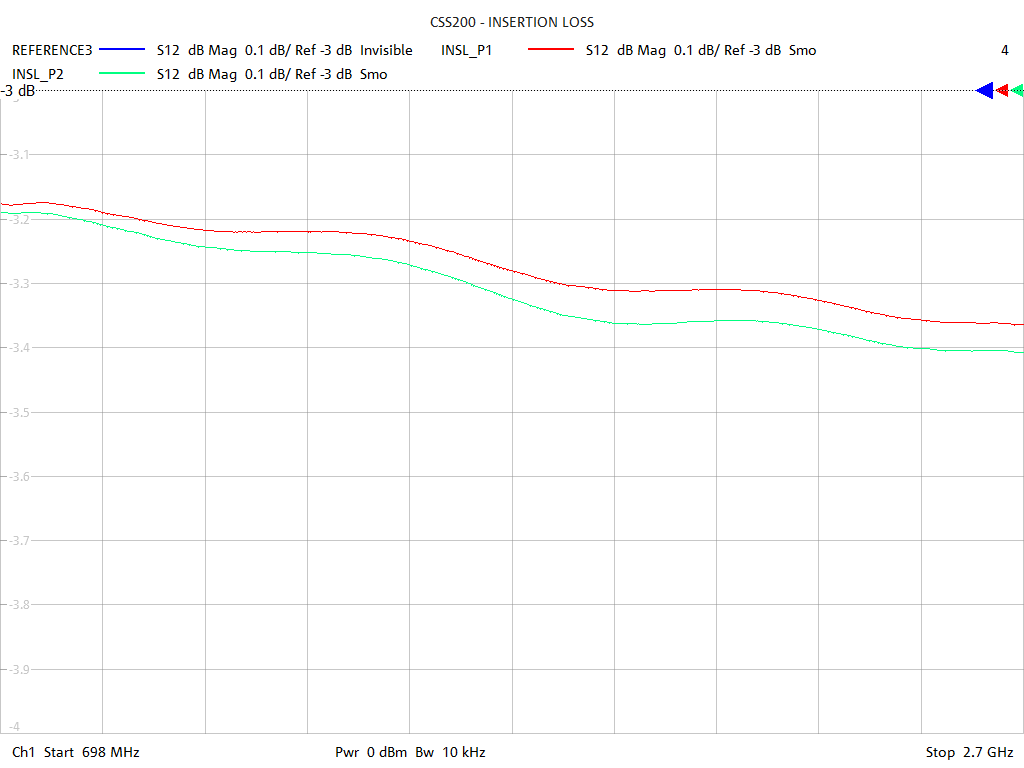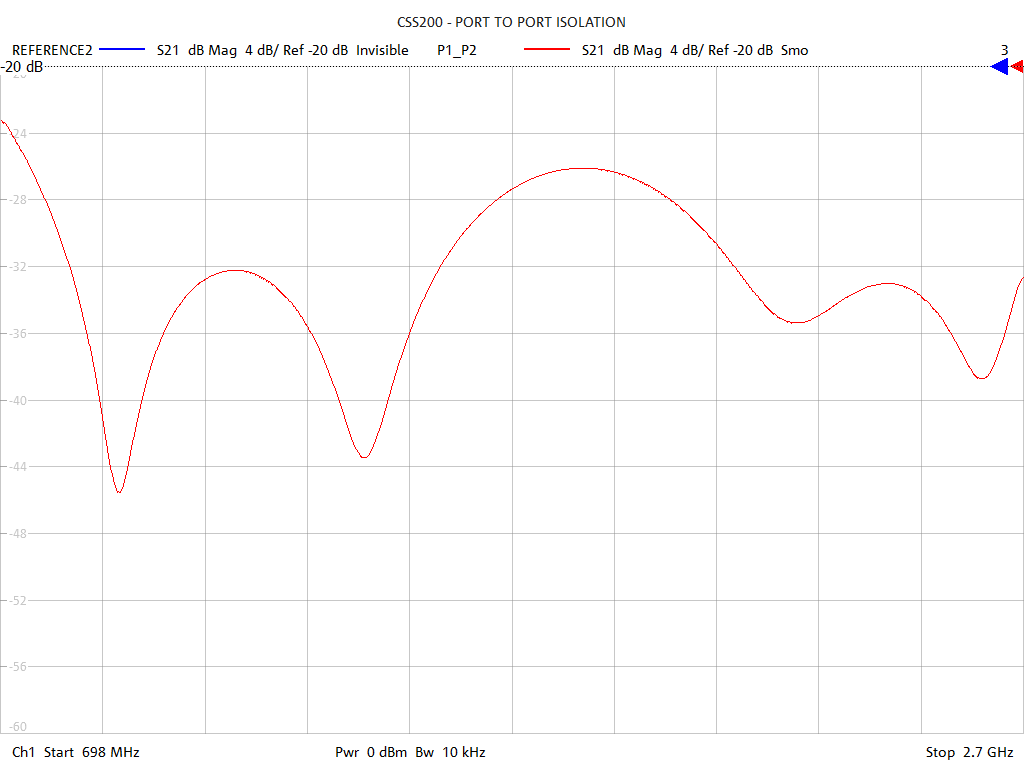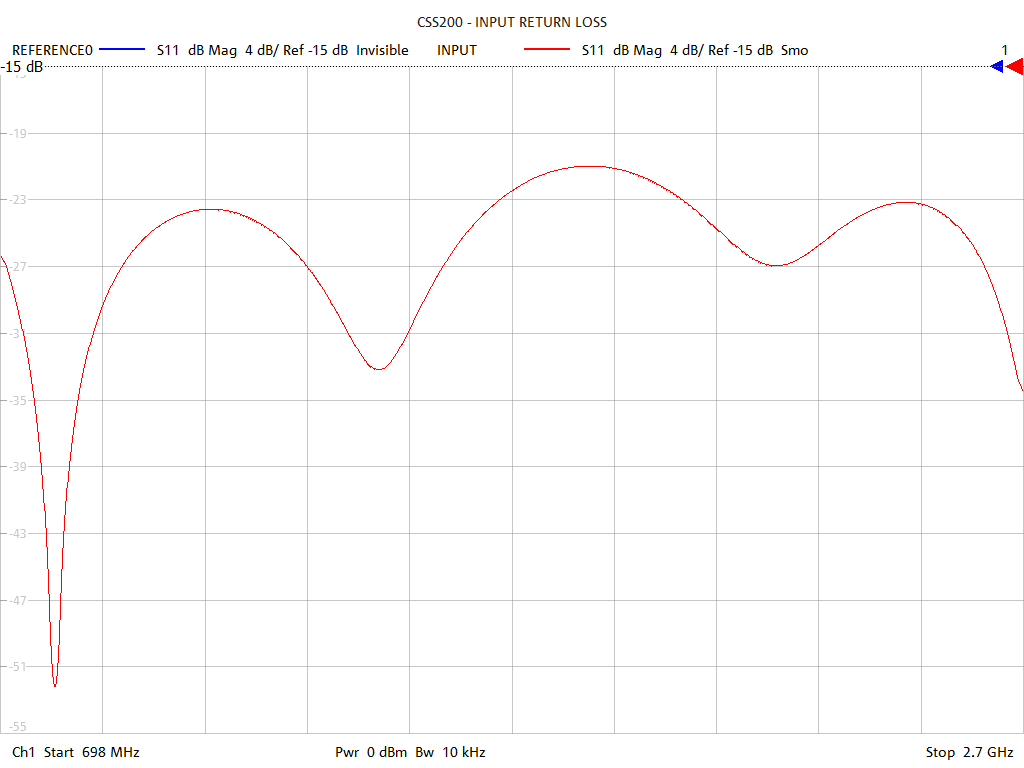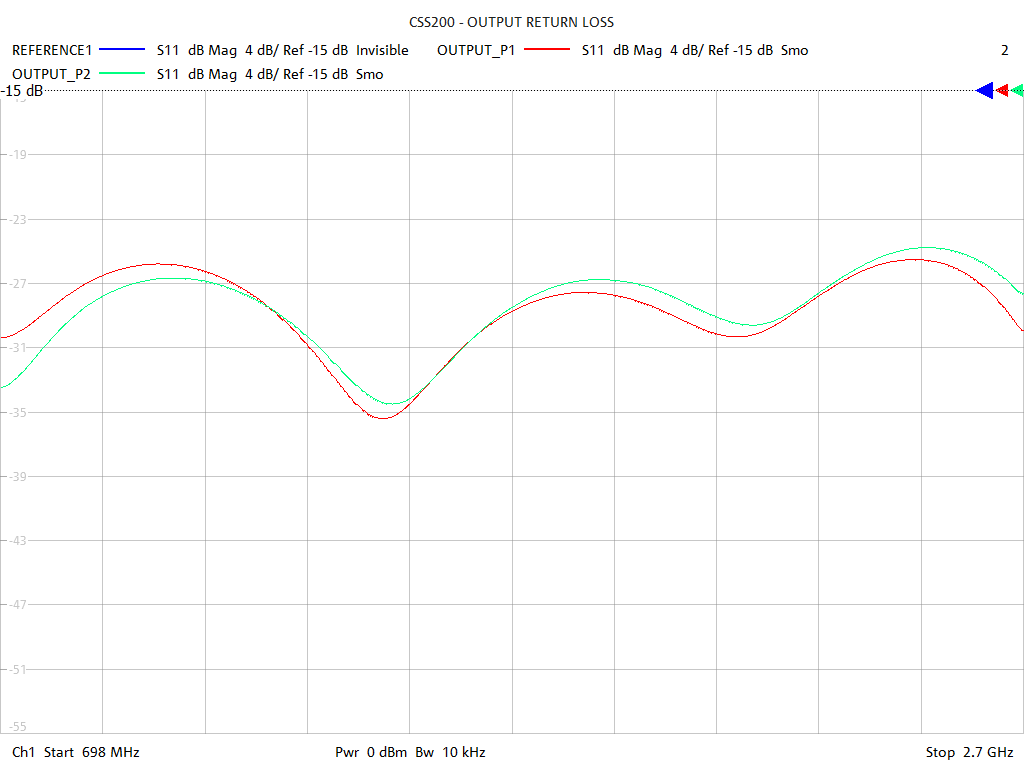CSS200, Current Steering GPS & L-Band Splitter
2-Way, N-Jack, 698-2700 MHz, DC Redundancy
USD icon click to view pricing Pop-up icon
Product Overview
- Wideband Frequency (698 - 2700 MHz)
- Low Insertion Loss (0.2 dB avg)
- High Port-to-Port Isolation (30 dB avg)
- Excellent VSWR (1.10 : 1 avg)
- 100 VDC & 1 A max both port
- Tri Alloy Type N Female (Jack) Low PIM
| Frequency Range |
Insertion Loss above 3.01 dB |
Amplitude Balance |
Phase Balance |
Isolation | Input VSWR |
Output VSWR |
|---|---|---|---|---|---|---|
| 698-2700 MHz | 0.4 dB max | 0.2 dB max | 2° max | 22 dB min | 1.25 : 1 max | 1.15 : 1 max |
| Mechanical Specifications | |
|---|---|
| Circuit Design | Simultaneous B-directional RF; Uni-directional DC |
| Connectors | N Female, 50 Ohm Coaxial |
| Connector Body | Brass, Tri-Alloy Plate |
| Connector Pin | Phosphor Bronze, Gold Plate |
| Connector Insulator | PTFE, Virgin Electrical Grade |
| Housing | Aluminum, Clear Chem Film |
| Operating Temp | -65°C to +85°C |
| Weight | 174 Grams |
| 2 Way Power Divider RF Input Ratings | ||
|---|---|---|
| Into Matched Load VSWR's |
In-Phase | 180° Out-of-Phase |
| 1.2 : 1 | 40 Watts | 40 Watts |
| 2.0 : 1 | 40 Watts | 10 Watts |
| ∞ | 20 Watts | 1 Watt |
| 2 Way Power Combiner RF Input Ratings | ||
| Input Signals | In-Phase | 180° Out-of-Phase |
| Coherent | 2 X 20 Watts | 2 X 0.5 Watts |
| Non-Coherent | 2 X 1 Watt | |
CSS200 Features & Benefits
Overview
CSS200 is a RoHS compliant, 2 way, wideband, 50 ohm, RF power divider, power combiner furnished with N jack female coaxial connectors. All wireless band frequencies in the range from 698 to 2700 MHz are covered with optimal RF performance. Max microwave input power levels up to 40 watts can be handled in both power splitter and power combiner applications. See 2 way power divider input rating tables for additional details. A special feature of the unit is the diode installed on each output as a DC fail-safe. This passes DC current in one direction, typically to power an active antenna, while blocking DC in the other direction. This allows you to connect multiple powered receivers to the device as a fallback if the first fails, while preventing damage to the receivers caused by cross-feeding DC inputs. Simultaneous bi-directional RF; Uni-directional DC. Max voltage rating at both ports is 100 VDC; maximum current rating is 1 A.
Electrical
The heart of the unit is a precision designed and etched Wilkinson type microstrip circuit on a low loss, high frequency, dielectric substrate. Electrical performance is highlighted by 0.4 dB max insertion loss (above the 3.01 dB power split), 22 dB min isolation, 1.25:1 max input VSWR and 1.15:1 max output port VSWR. Equal power split and symmetry is displayed by 0.2 dB amplitude balance and 2 degrees phase balance. Narrow band RF performance over your frequency range may be even better. See 2 way power divider test sweeps for details.
Mechanical
Mechanical features include precision CNC, brass, 50 ohm Type N female coaxial connectors with tri alloy plating to insure tarnish resistance and low PIM operation. Connector pins are gold plated phospher bronze for reliability and low contact resistance. Virgin electrical grade PTFE support insulators captivate the contact pins enabling trouble free coaxial connector mating. Long term operation and superior shielding is assured by the rugged CNC machined aluminum housing with clear chemical film finish. Secure mounting is provided by two 0.125" diameter (3.18 mm) through holes. RoHS construction includes no-lead solder and a finish free of hexavalent chromium.
Physical
Housing dimensions are 1.98" wide by 1.98" deep by 0.88" high (50.3 x 50.3 x 22.2 mm). The N Type female (jack) connectors extend 0.65" (16.3 mm) from the housing. Operating temperature range is from -65°C to +85°C. Weight is 174 grams. See 2 way N Type splitter outline drawing for more information.
Applications
The CSS200 2-way, N-jack, 698-2700 MHz power splitter combiner is ideal for a wide range of wireless radio frequency microwave applications on both transmit and receive sides, ranging from amplifier sharing & receiver combining to antenna splitting, and is deployed world wide in networks encompassing 700 MHz Public Safety Band, 800 MHz cellular, GSM 850, 900, 1800 & 1900, PCS 1900, 1 GHz to 2 GHz L-Band, GPS, W-CDMA-3G, UMTS, TETRA, RFID, IEEE802.11b/g, 2.45 GHz ISM, Wi Fi and 2.3 GHz & 2.5 GHz WiMAX.

